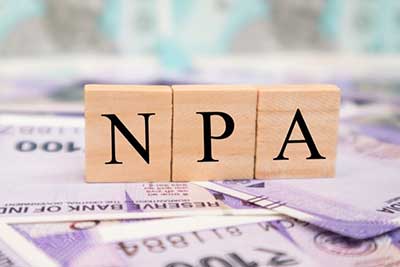Date: 30/12/2022
Relevance: GS-3: Indian Economy and issues relating to Planning, Mobilization of Resources, Growth, Development, and Employment.
Key Phrases: non-performing loans, loan write-off, Fugitive Economic Offenders Act, Insolvency and Bankruptcy Code (IBC), SARFAESI Act, asset reconstruction companies
Why in News?
- Recently, Finance Minister told Parliament that Indian banks have managed to recover 13 percent, or ₹1.32 lakh crore, out of the whopping ₹10.09 lakh crore in non-performing loans written off in the five years from FY18 to FY22.
- This includes recoveries from all available mechanisms including debt recovery tribunals, cases resolved under the Insolvency and Bankruptcy Code (IBC), action taken under the SARFAESI Act, sale of non-performing loans to asset reconstruction companies, and so on.
What is a loan write-off?
- Writing off a loan essentially means it will no longer be counted as an asset. By writing off loans, a bank can reduce the level of non-performing assets (NPAs) on its books. An additional benefit is that the amount so written off reduces the bank’s tax liability.
- Typically, banks take four-five years to completely write off loans after initially classifying them as non-performing assets (NPAs).
Recovery ratio:
- The recoveries ratio may not seem so bad when benchmarked against global numbers where the average recovery from bad loans is estimated at 7 to 12 percent.
- Recoveries against written-off loans in India also seem to have improved from the 7 percent levels they were stuck at for many years.
- But the figure is modest when seen in the context of the expanding armoury of weapons handed out to Indian banks in recent years to bring defaulters to book.
Why do banks resort to write-offs?
- The bank writes off a loan after the borrower has defaulted on the loan repayment and there is a very low chance of recovery.
- The lender then moves the defaulted loan, or NPA, out of the assets side and reports the amount as a loss.
- After the write-off, banks are supposed to continue their efforts to recover the loan using various options. They have to make provisioning as well.
- The tax liability will also come down as the written-off amount is reduced from the profit.
What is an NPA?
- Any loan provided by a bank can turn into an NPA if the principal or interest payment for the same has not been paid for over 3 months (90 days).
Tools of recovery:
- Debt Recovery Tribunals:
- They were established to facilitate debt recovery involving banks and other financial institutions with their customers.
- SARFAESI ACT, 2002:
- It allows banks and other financial institutions to auction residential or commercial properties (of default) to recover loans.
- The Act provides three alternative methods for recovery of
non-performing assets, namely:
- Securitisation,
- Asset Reconstruction and
- 3Enforcement of Security without the intervention of the Court.
- Insolvency and Bankruptcy Code:
- IBC aims to reorganize and resolve the insolvency of corporations, individuals, and partnerships in a time-bound manner.
- Fugitive Economic Offenders Act:
- It empowers banks to summarily seize assets, India has made significant strides in tightening the ecosystem for bad loan recoveries.
- It intends to confiscate assets and properties of economic offenders that evade prosecution by residing outside the jurisdiction of Indian courts.
- National Asset Reconstruction Company Ltd (Bad Bank):
- NARCL has been incorporated under the Companies Act and has applied to the Reserve Bank of India for the license as an Asset Reconstruction Company (ARC).
- The plan is to create a bad bank to house bad loans of ₹500 crore and above, in a structure that will contain an asset reconstruction company (ARC) and an asset management company (AMC) to manage and recover dud assets.
Reasons for reducing NPA:
- If non-performing assets are expected to fall to a multi-decade low of
4 percent in FY24 (as per CRISIL), it is mainly due to
- Slump in private capex,
- banks holding back on project lending, and
- deleveraging by India Inc.
Room for Improvement:
- Lending and underwriting practices still have substantial room for improvement.
- For instance, some banks have been increasing their exposure to holding companies based on ‘operating comfort’ provided by their subsidiaries which are already leveraged to the hilt.
- This practice was one of the key reasons why group-level loan exposures turned bad in the previous cycle.
Need for pre-emptive action:
- Cash flow-based financing, a model where it is difficult to time risk, is gaining momentum.
- Such practices are prevalent to a lower extent today compared to the infra-boom days.
- But as they embark on bankrolling the next capex cycle, the best way for banks to reduce the need for write-offs is to nip NPA accretion in the bud.
- This may require more pre-emptive action when loans slip into SMA (special mention account) status, rather than waiting for them to turn NPA.
Way forward:
- RBI on its part must nudge banks to provide more granular disclosures on their loan write-offs and recoveries, on a systematic basis.
- A sharper time-wise breakdown of NPAs, write-offs, and recoveries is essential to understand the proportion of bad loans resulting from wilful defaults and promoters siphoning off funds, as opposed to economic cycles or business exigencies.
- Where there’s clear evidence of wilful default, a name-and-shame regime can act as a deterrent to wrong-doers, and also alert stakeholders.
Source: The Hindu BL
Mains Question:
Q. NPA management must be more comprehensive in order to prevent NPA accumulation. Discuss.






















